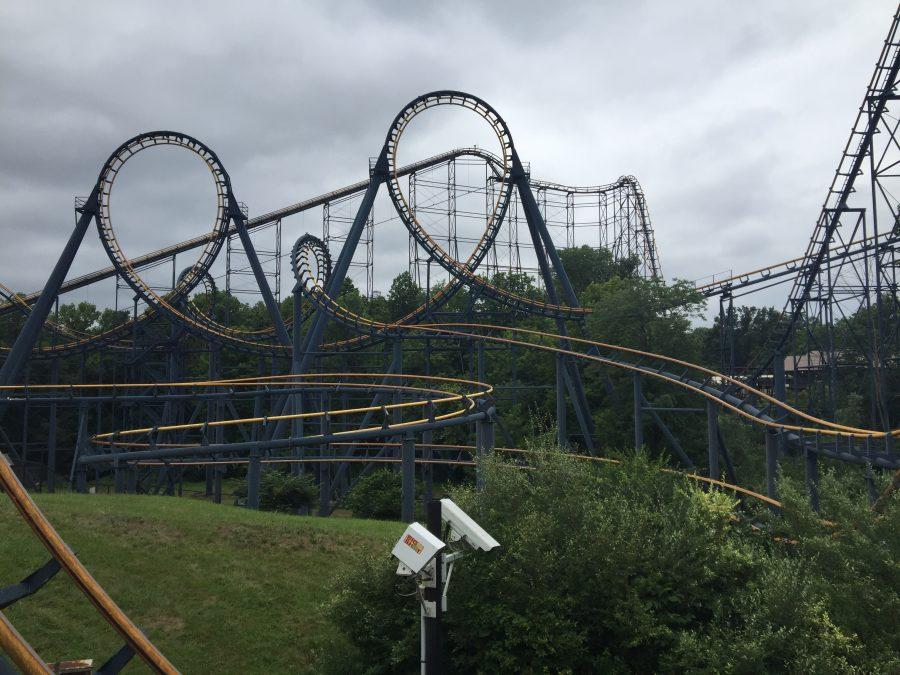A breakdown of the fears surrounding amusement parks.
In 2016, 1,197 amusement ride-related injuries occured in North America. Out of context, this statistic is perceived negatively. The same year that amusement parks produced 1,197 accidents, more than 148 million people visited the top 20 theme parks in America.
While any injury statistic is saddening, it’s pretty impressive that out of the many amusement parks throughout North America, only more than 1,000 injuries prevailed. According to those numbers, only one out of every 123,642 people are injured at amusement parks.
It is very unlikely that the average person will injure themselves because of activities at an amusement park, yet there is a stigma about the dangers of visiting one, even though many other mundane activities are much more worrisome.
Amusement parks, Fear Fest and recreational facilities such as Skyzone have one thing in common: they all sell with the premise of high-energy, high octane thrills. Individuals go to skydiving complexes to fall thousands of feet through the air. People visit amusement parks to ride roller coasters and other attractions that can also drop you hundreds of feet through the air.
Types of environments such as these invoke a culmination of different common phobias. Acrophobia, the fear of heights, affects more than 23 million people. High-octane activities are scary to some because they lessen our visual orientation, which taps into our inner thoughts saying, “This isn’t right.”
Human bodies usually don’t soar through the air or fly out of seats on a roller coaster, so the combined thrills of speed and height are too much for many people to handle. More dangerous mundane activities, such as driving or biking, are much more common in everyday lives, and many people are more used to them, thus being less scared by them. If being inside a car were less common, there would be plenty more people afraid of riding or driving in a car.
Phobias are a large factor for fearing high-level thrills such as roller coasters, but the real fear for many people comes from the horror stories. While many stories can just be rumors, serious injuries and deaths happen every year. Whenever an accident occurs at a highly public area or amusement park, there is definitely media coverage. When someone is hurt or dies on a roller coaster, many media outlets report the story nationally.
Roller coasters thrive on being safe to ride, but still, have connotations to mechanical failures that make many afraid of them. Much like airplanes, accident involving a roller coaster would be covered heavily by the news since it hardly ever happens.
It’s all about the rarity.
Car crashes are usually reported locally but are never reported on a national scale because hundreds of them happen every day. It would be a bad year for amusement park deaths if more than two people died. If there were more than a few deaths a year, there would be articles written about how these rides should be shut down.
When people do get injured, it taps into the fears of the general public that these rides are unsafe. Local and nationwide news outlets will jump at the opportunity to talk about it because of its scarcity. These articles further the fear in people’s minds that roller coasters are unsafe. Roller coasters are still very safe, with most accidents not caused by mechanical failure. One recent tragedy occurred when a man was killed at Cedar Point by getting hit by an oncoming roller coaster train. The man was trespassing by trying to get his hat after it fell off while he was riding. The ride did nothing mechanically incorrect in this instance, rather the person who jumped a fence to try and reclaim his hat. Tragedies like this are sad, but the ride shouldn’t be to blame when it is a human error.
The other factor that makes rides seem dangerous is the marketing the parks and organizations do themselves. Many of these places capitalize on the fear aspect of the ride because while many people are turned away by this, there are as many people who become enthralled by the thrills. Companies such as Six Flags and Disney capitalize on fear with their Fright Fest or Tower of Terror. More local attractions such as Fear Fest also profit on the fears of people.
These rides market themselves as scary because it’s a draw. Not all extreme rides are shown as scary, but the marketing for places such as Fear Fest phase into the perception of other attractions in the same vein. This makes the perception of the overall amusement industry more dark and sinister.
Though marketing, movies, and news may suggest otherwise, amusement attractions and rides are perfectly safe to ride. While there are many negative connotations associated to the fear and danger of attractions such as these, in reality, there’s plenty of more mundane objects and tasks that you could die from more easily than strapping yourself onto a roller coaster. Car accidents topped 400000 last year in the US alone. Focus less on the artificial fear and more on the real dangers at hand in everyday life.
What fears hold you back in life?













































































